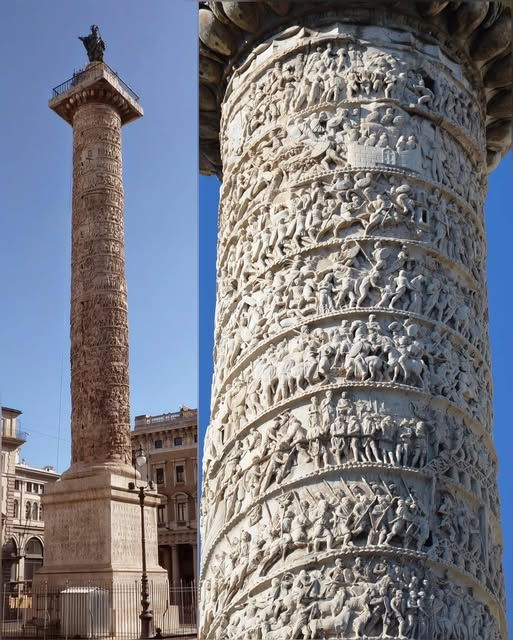
In the heart of ancient Rome, where shadows of emperors still linger among weathered stones and fountains whisper stories into cobblestone alleys, a single column pierces the sky like a memory that refuses to fade. It rises above the Forum of Trajan—majestic, defiant, and exquisitely adorned with a ribbon of carved battle scenes that coils upward in an eternal spiral. This is Trajan’s Column, a monument not only to military triumph but to the enduring ambition of empire, and the fragile humanity it left etched behind.
Constructed in 113 AD, the column stands 35 meters tall, or nearly 100 Roman feet—a deliberate nod to its patron, Emperor Trajan, who wished the monument to match the height of the hill that had been leveled to build his great forum. But its grandeur isn’t found in scale alone. What draws the eye and soul is the 200-meter-long frieze that winds around its surface like a scroll of time, depicting over 2,600 figures in bas-relief, all narrating a single epic: the emperor’s conquest of Dacia, in what is now Romania.
The story begins not with violence but with preparation. Roman soldiers construct bridges, consult maps, and receive orders. It’s a quiet prologue that speaks of discipline, logistics, and unity—pillars of an empire that stretched from Britannia to Mesopotamia. As the spiral unfolds, the scenes grow more chaotic: rivers are crossed, fortresses stormed, tribes subdued. Yet even amidst the fury of war, there is balance in the composition. Trajan appears dozens of times, always calm, always in command. He is the axis around which the column—and the empire—turns.
This visual narrative, unlike any carved before or since, is both propaganda and poetry. It glorifies conquest, yes—but it also documents, in painstaking detail, the machinery of empire. Armor, siege engines, hairstyles, rituals—nothing is left vague. It is an encyclopedia in marble, and a testament to Roman obsession with control over not just people and territory, but memory itself.
And what of the Dacians? They are not mere caricatures of defeat. They are proud, defiant, at times dignified even in surrender. Their women plead for mercy, their kings commit suicide rather than be paraded in chains. It is here that the column transcends triumphalism. Though carved by victors, it cannot help but reveal the cost of victory. There are no gods descending from clouds, no divine lightning bolts—only humans, caught in the grind of imperial ambition.
The artist, whose name remains lost to time, sculpted this epic with a depth of empathy that belies the monument’s political intent. One can imagine him—chisel in hand, eyes narrowing at the stone—drawing life from cold Carrara marble. Perhaps he had seen the war himself. Perhaps he had lost a brother to it. Or perhaps he simply understood what history often forgets: that every statue of glory casts a shadow of grief.
When archaeologists and historians stand before the column today, they see more than art—they see an ancient archive. It tells us how the Roman army moved, how they built, what standards they bore, how they buried their ᴅᴇᴀᴅ. Yet it also raises questions. How much of this is truth? How much curated myth? Where do we draw the line between memory and manipulation?
At the summit of the column once stood a statue of Trajan himself, arms extended toward the heavens. That figure is long gone, replaced centuries later by a statue of Saint Peter—a symbolic baptism of imperial might into Christian virtue. Yet the column beneath remains untouched. Rome changed gods, emperors, languages, and laws—but this spiral of stone endured, unmoved by centuries of invasion, flood, and ruin.
For the Roman people of Trajan’s time, this column was more than a monument—it was a mirror. They could walk around it, trace the spiral with their eyes, and relive the glory of their legions. But for us, it has become something else. It is a time machine. A vertical manuscript. A silent storyteller standing watch over a fallen world.
It’s difficult not to feel something personal when standing at its base. The carved figures, though ancient, speak with astonishing immediacy. Here is a soldier leaning on his shield, weary from the march. There is a Dacian chieftain, arms raised in defiance before the blade falls. There is Trajan again, delivering judgment with serene finality. You look up, and up, and up—and realize that this is not just the story of Rome, but of civilization itself: how we build, how we fight, how we remember.
And as sunlight strikes the column at dusk, shadows deepen in the carved recesses, and the spiral seems to move again—not with the violence of battle, but with the slow, unrelenting churn of history. Empires rise, burn bright, and fade. Names are forgotten. Statues crumble. But this stone column, wound with the breath of a thousand lives, still stands—whispering across centuries.
What will our monuments say about us? Will they be as honest in their beauty and brutality? Will they show not just the victories we claim, but the humanity we cannot escape?
For now, Trajan’s Column waits in the center of Rome, surrounded by traffic and tourists, pigeons and time. It needs no voice, no guards. It speaks in stone, and it remembers for all of us.